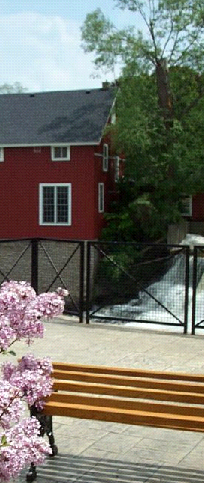
Old Honeoye Falls – Shows the covered railroad bridge above the upper falls (c.1853)
History of Mendon: A Capsule HistoryBy Diane Ham, Mendon Historian It is difficult to imagine the Town of Mendon once being a dense forest and also to visualize Honeoye Creek as ever having been a roaring stream. The Town of Mendon today is much different from the log cabin era of 1790 when oxen pulled covered wagons through mud holes, when our pioneer families planted the seeds of settlement, and wolves howled in the woods behind the clearings. And this was the beginning. The Sullivan-Clinton Expedition was ordered by President George Washington in 1779, to break forever the power of the Seneca Indians who fled west hoping for protection from the British on the Niagara Frontier. The Sullivan Expedition was successful and hastened the development of Western New York. When peace came and the land in the Finger Lakes and Genesee River areas was opened for sale, the word was passed along, and settlements sprang up rapidly as people rushed to buy land either for speculation or to farm for themselves. They set out on foot or horseback and drove their stock, while their families usually came by water or covered wagon. Very often, the heads of families or older sons came ahead as land hunters, made their selection, bought land, built a hut or cabin and then returned along the trail to pass the winter at the old home and to sell their farm before bringing their family to Mendon. In January, 1789.Ontario County was formed from Montgomery County. The Town of Mendon was originally part of Ontario County and was annexed to Monroe County when it was formed in 1821. Mendon was organized in 1813, and the first town meeting was held in April of that year, at the home of Thomas Ewer (later adjourned to his barn) at the corner of West Bloomfield and Cheese Factory Roads. The Honorable Timothy Barnard was elected Moderator. Mendon most likely got its name from one of its early settlers, Caleb Taft, who came here from Mendon, Massachusetts. Most of the early settlers to Mendon came from Connecticut, Massachusetts, Vermont, and from the eastern counties of New York State, where their prospects for existence were poor. Between 1792 and 1800, 26 families settled in Mendon, most of them near “Mendon village” or East Mendon, as it was called in early days. They were Samuel Miller, Robert Briggs, Daniel Sines, Cornelius Treat, Loren Wait, Jason Cross, Dan Williams, Joseph Bryant, Abraham DeGarmo, John Park, John Silley, Dr. Joel Brace, Jonathan Brace, Henry Bryant, Jonas Allen, Abel Parkhurst, Philander Barrett, Nathaniel Williams, Lyander Barrett, Medad Barrett, Edward DeWolf, Samuel Lane, Amaziah Park, Benjamin Park, Ralph Strong and Caleb Taft. In 1800, a road was opened from East Mendon westward. From this time until 1805, numerous groups passed through the area from every part of New England. Before long, the country became more thickly settled, and a few men started in the milling business. Sites along the streams were selected for their waterpower. A person looking for a mill site explored up and down the stream for a desirable location, and when one was found he went before the Town authorities to secure a writ of “ad quod damnum.” This enabled the miller to have the adjoining land officially examined, and the possible amount of damage by making a dam was estimated. Mills were so great a public necessity that they were permitted to be located on any person’s land where the miller thought the site desirable. Thus, the local farmers found a market for their wheat, corn and oats at the grist mills throughout the 19th century and into the early years of the 20th century. “Mendon village” was the first post office established in the Town. Timothy Barnard was the first postmaster at his residence a mile northwest of the village. A mile west of the “village” stood the first schoolhouse. The entertainment of travelers and emigrants began in an early log cabin tavern; later a more pretentious structure known as the East Mendon Hotel which was built in 1812 on the northwest corner of the four corners. Jonas Allen was the first supervisor. By 1860, the Town of Mendon contained three hamlets, the village of Honeoye Falls and 23,000 acres of excellent farmland. Mendon contained two churches, a steam flouring mill, a steam sawmill, a foundry, and twenty houses. Mendon Center had a grist and saw mill and 15 houses and was an early Quaker settlement with choice land for farming. Sibleyville was a busy hamlet in the southwest part containing a sawmill, machine shop which manufactured carding machines, a foundry, water grist mill and saw mill which doubled as a cider mill in the fall, a woolen mill, cobblestone meeting house and about a dozen houses. Later on, about 1896, Rochester Junction became a hamlet with a railroad station, hotel and post office. Honeoye Falls was, and still is, the only village in the Town of Mendon. The population of the Town of Mendon in 2000, including Honeoye Falls is approximately 8,370 and embraces an area of approximately 39 square miles.
CONTACTS |

|